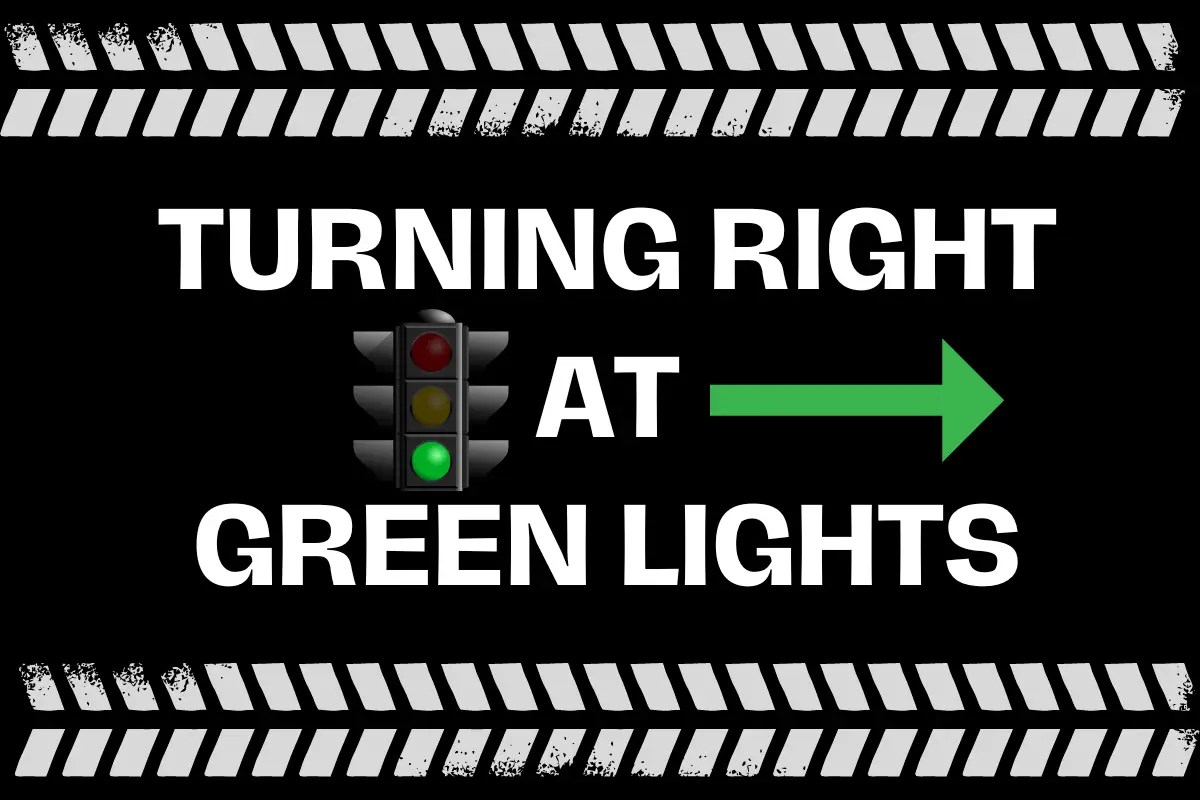How To Turn Right at Green Lights – Beautiful British Columbia, Canada
Introduction…
Knowing how to turn right at green lights safely is another one of those important skills that learners, new drivers, and all drivers must practice to get really good at.
And while turning right at green lights doesn’t seem as dangerous as turning left at an intersection, it’s somehow more difficult and complicated to teach to a new driver (and to learn).
That is why I would always teach left turns at traffic lights first. Also, learners would know how to turn left and could avoid terrifying their parents too much when they went to practice driving.
BC Motor Vehicle Act – Turning At Intersections, Green Lights
Turning at intersections
165 (1)If the driver of a vehicle intends to turn it to the right at an intersection, the driver must cause it to approach the intersection and then make the turn as close as practicable to the right hand curb or edge of the roadway.
Green light
127 (1)When a green light alone is exhibited at an intersection by a traffic control signal,
(a) the driver of a vehicle facing the green light
i). may cause the vehicle to proceed straight through the intersection, or to turn left or right, subject to a sign or signal prohibiting a left or right turn, or both, or designating the turning movement permitted,
(ii) must yield the right of way to pedestrians lawfully in the intersection or in an adjacent crosswalk at the time the green light is exhibited, and
(iii). must yield the right of way to vehicles lawfully in the intersection at the time the green light became exhibited, and
(b). a pedestrian facing the green light may proceed across the roadway in a marked or unmarked crosswalk, subject to special pedestrian traffic control signals directing him or her otherwise, and has the right of way for that purpose over all vehicles.
Who Has The Right Of Way When Turning Right at Green Lights?
Wondering who has the right-of-way when turning right at green lights? Nobody really “has the right-of-way.” My driving school would have absolutely positively fired me if I ever started teaching people that they simply ever “had the right of way.”
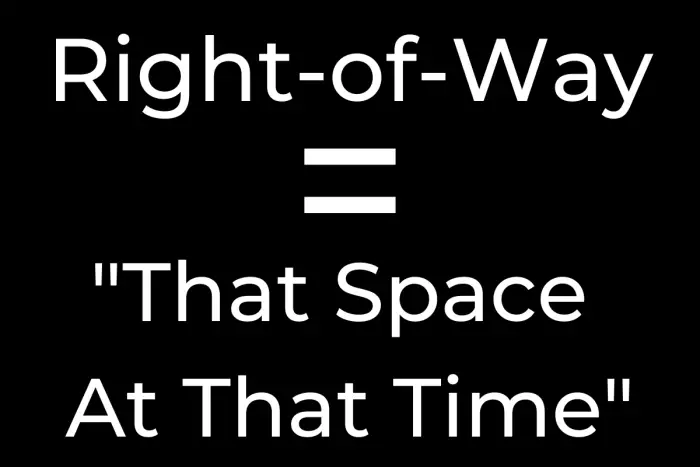
Rather than thinking someone “has the right of way,” certain road users should yield to others. It doesn’t mean they’re actually going to. Driving is dangerous, and we utilize this kind of attitude to greatly reduce risk.
Pedestrians and cyclists may proceed first. Right turns must yield to people in the crosswalk. Left turns must yield to people in the crosswalk as well as any opposing or conflicting traffic.
Who has the right of way when turning left or right on a solid green light?
Pedestrians may proceed across the crosswalk when they have the “walk” signal. Right-turning vehicles must yield to pedestrians and cyclists. Left-turning vehicles must yield to pedestrians, cyclists, and any other conflicting or oncoming traffic, including right-turning vehicles when there is a solid green light at an intersection.

Yield to whoever was there first
One good thing to realize about driving right-of-way is that no matter what kind of traffic control device there is – or isn’t – at any particular location, and no matter what is “supposed to happen,” drivers must legally yield to any other road user that has entered any space before they did. If it got there before you, yield.
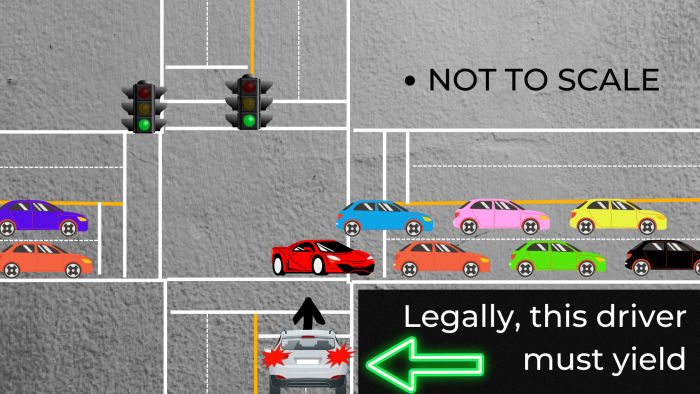
How To Turn Right – Do You Have To Stop At a Green Light When Turning Right?
No, don’t stop at a green light when you’re turning right unless there’s a good reason: you’re yielding to pedestrians and/or cyclists, or if you’re stopping for a particular reason such as another vehicle already in the space. If there are left-turning vehicles in the intersection, they are supposed to be yielding to you.
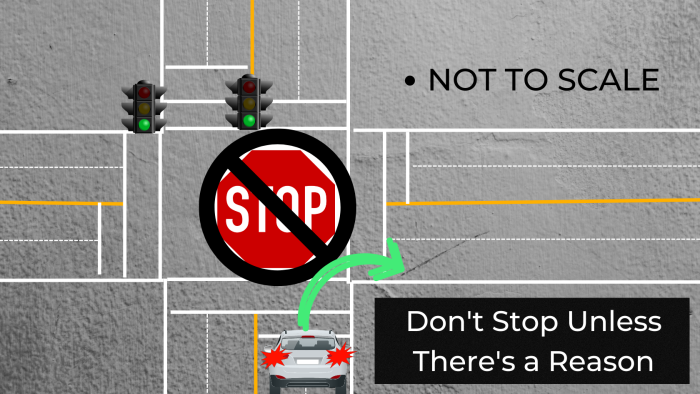
If there are no pedestrians and/or cyclists to yield to, then slow to around 20 km/hr, shoulder check, and simply turn. Keep an eye on the left-turning driver in case they are planning to take your right-of-way; your particular space at that particular moment.
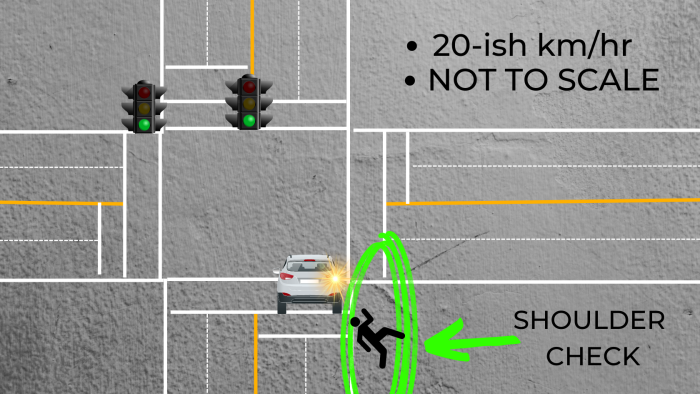
Can You Turn Right On a Green Light Without An Arrow?
Yes, you can turn right on a green light without an arrow. If you’re facing a green light, the green light means go, just yield to pedestrians and/or cyclists. Arrows are an optional traffic control device, used for some intersections.
How to Turn Right at a Green Light – Know Who You Are Yielding To
Do you have to yield when turning right on the green?
In theory, when you are turning right on a green light, the only other road users you normally need to yield to are pedestrians and cyclists.
Yielding to the left-turning vehicle (sometimes)
Of course, you may need to yield to someone or something else – such as a left-turning vehicle, if it has already turned and is subsequently in your way.
Drivers who are turning left are supposed to yield to drivers who are turning right in this situation. But of course, in the real world, things may be different, and it’s good to get ready for this and accept it as a simple fact.
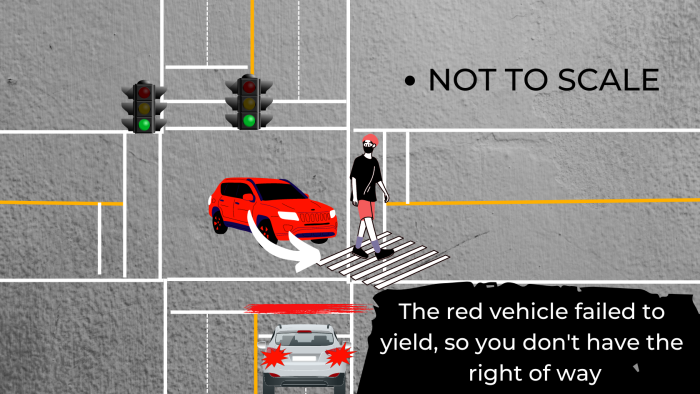
That’s why it’s the only safe way to think, “that car is supposed to yield“
… Rather than, “I have the right of way.” Not trying to be dramatic, but the difference between these two ideas is quite realistically the difference between a crash and not a crash.
If the other car doesn’t yield
If they don’t yield, then you don’t have the right of way. It’s very simple. If no one gave me birthday-cake-flavored Timbits for my birthday, then I don’t have them. Oh, maybe that’s a little different.
How to Turn Right – Pay Attention To Your Vehicle Positioning
Shoulder check and get your vehicle closer to the curb

Whenever possible, try to move your vehicle closer to the curb before the right turn so that vehicles behind you can possibly fit by in case you do stop for pedestrians or cyclists.
Mirror checks and shoulder checks before right turns
Before you move over, use a right-mirror check and a right-shoulder check to ensure there are no bikes or anything else that you would be potentially in conflict with, in your blind spot. Check out my article about blind spots to learn more.
If there are no pedestrians and any left-turning vehicle is clearly yielding, then simply turn.
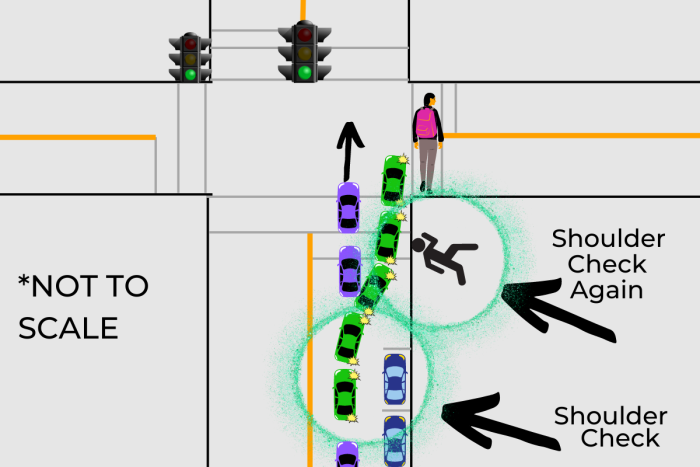
How To Turn Right At Green Lights – Watch For Pedestrians
If you do see pedestrians crossing
If you see pedestrians, move forward into the intersection a bit in order to line up your vehicle with where you are about to turn.

Don’t stop behind the white stopping line while waiting for pedestrians
In other words, do not wait behind the stopping line as you would if your light were red. You do want to pull forward as long as there’s no other right-turning vehicle in front of you.
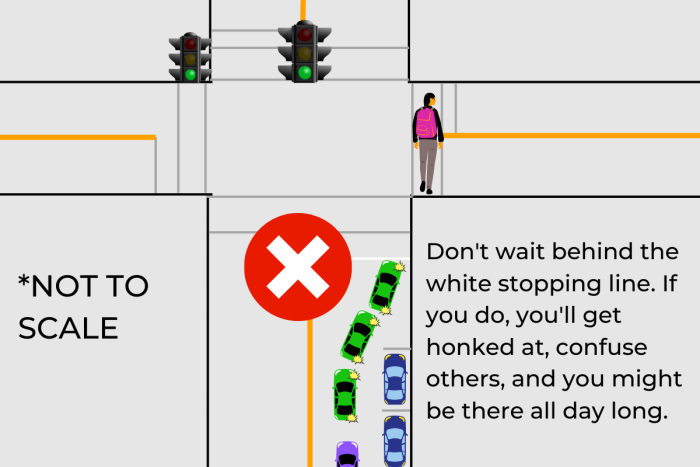
There are two reasons for this:
1) It clearly tells the driver of any left-turning car that you are seriously getting ready to turn right and take your turn, and you are merely waiting for the pedestrians.
If you wait behind the white stopping line, the driver may think that you want him/her to go first, because it looks like you’re leaving an insanely large amount of space in front of you for no reason
Keep in mind, there should be no pedestrians walking on the perpendicular crosswalk; so it’s fine to block it; in fact, you kind of have no choice in most cases.

Second Reason
The other reason has to do with the traffic light
Legal reasons
If you move forward into the intersection, wait for slow or many pedestrians, and then the light goes yellow, then you’re still allowed – and you should – exit the intersection after the pedestrians, but – in theory – before any left-turning vehicle.

Again, this is in theory, where there are also perfect roses and rainbows with a pot of gold waiting under them for anyone to freely take.
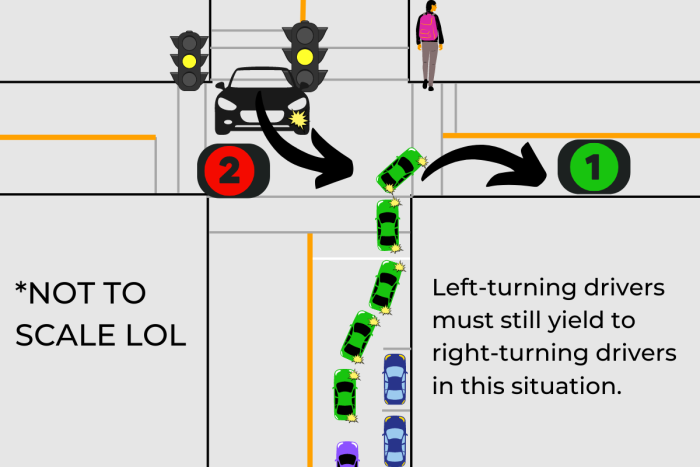
If the left-turn vehicle doesn’t yield
Sometimes, the left-turning vehicle may try to go first and you do need to keep an eye on that. If they don’t yield to you, simply let them go first and then turn after them.
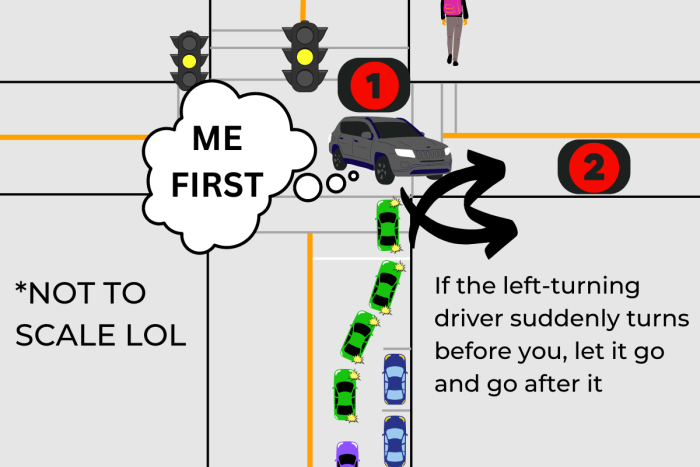
Life doesn’t always go as we plan. But it can go two seconds after that, which is no big deal really. My philosophy is I don’t really care who is right and wrong – or who is perfect because nobody is – I care that I get to where I’m going safely, that’s it.
How to Turn Right – More Details On Pedestrians
How much time/space to give pedestrians?
Give the pedestrians some extra time and space before you turn.
You don’t have to necessarily wait until they’ve walked completely across the entire crosswalk. In certain intersections, that might mean waiting for them to walk past multiple lanes, which may seem unnecessary.
As a rough guideline, you should wait until they’re at least past the yellow line if they’re walking away from you, or until they actually step onto the sidewalk if they’re walking toward you.
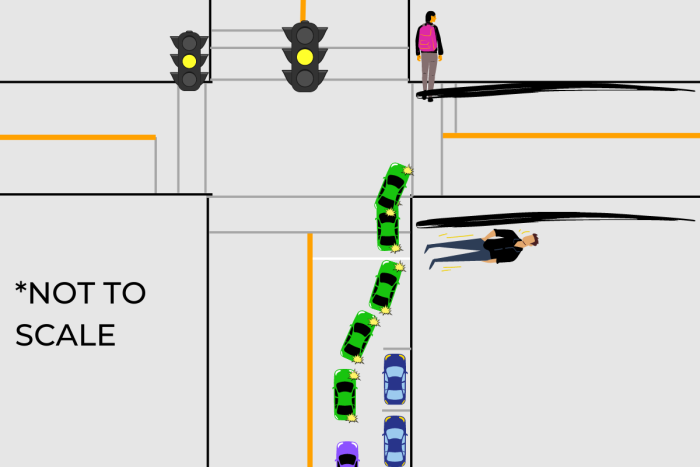
Do another quick shoulder check before you turn to make sure there are no more pedestrians about to walk; sometimes there are more, running to try to make it across in time because they’re in a hurry.

When you’re learning how to turn right at an intersection, it’s good to be aware of some things that pedestrians have been known to do:
- Drop something such as keys or phone in the middle of the crosswalk and have to stop to pick it up
- Change their mind in the middle of the crosswalk and start walking in the opposite direction
- See their friend in the middle of the crosswalk and stop and chat for a few seconds before continuing to cross the road
- Trip and fall, and before getting up, notice their shoelace is untied and decide to quickly tie it up before continuing
- Bolt out of a building or a bus and start sprinting across the crosswalk as fast as they can, like a cheetah, out of nowhere
- Pedestrians with children may be extra slow and unpredictable
- On windy days, umbrellas that aren’t hardcore may turn inside out and this can be distracting to the pedestrian holding it
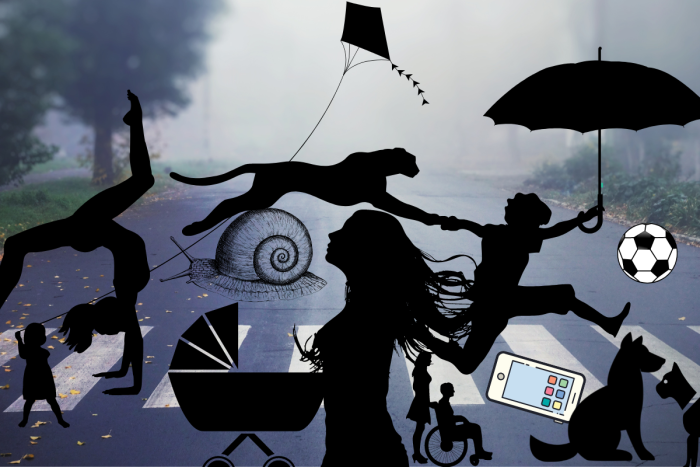
If there’s a median/boulevard
If there’s a median/boulevard in the middle of the road, you can turn when the pedestrian has passed that point.
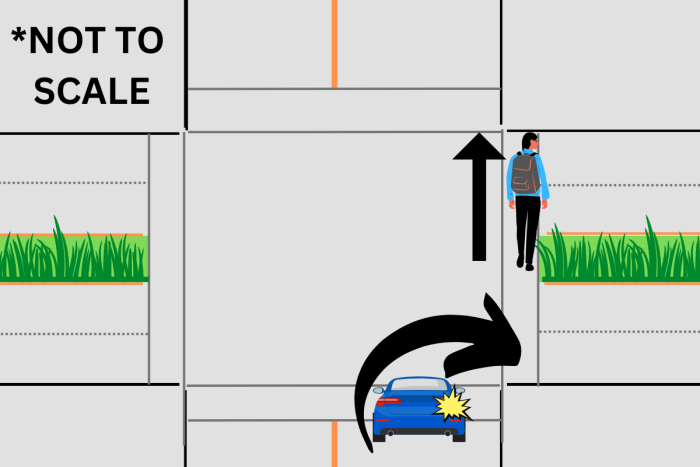
That Oncoming Left-Turning Vehicle when Turning Right on a Green Light
Do keep an eye on the left-turning vehicle.
The driver doing a left turn is supposed to be yielding to you. However, this doesn’t mean that they will.
If it turns when it shouldn’t, then simply let it go. Let it go first, like, literally, but also if you’re the type who holds a grudge; it’s just not good for you! Let it go first and go after it. Simple.
We are staying alive here, and getting to our destination in one piece, not proving a point about right and wrong. Humans are imperfect and that’s a fact. Maybe that person is having a bad day, which can happen to any of us. We never know what is going on in their life so it is best not to judge and just continue when it’s safe.
Dealing With Multiple Lanes when Turning Right on a Green Light
If there are two lanes, then avoid turning at the exact same time as the left-turning vehicle.

You need some extra space around your vehicle at all times and turning at the same time robs you of this safety cushion. It is part of being a safe, defensive driver. Read my full article on how to be a defensive driver and manage the space around your vehicle.
Try to time it so you turn before it or after it, but not at the same time. If you avoid turning at the same time, it’s a lot more difficult to have a collision with that vehicle.
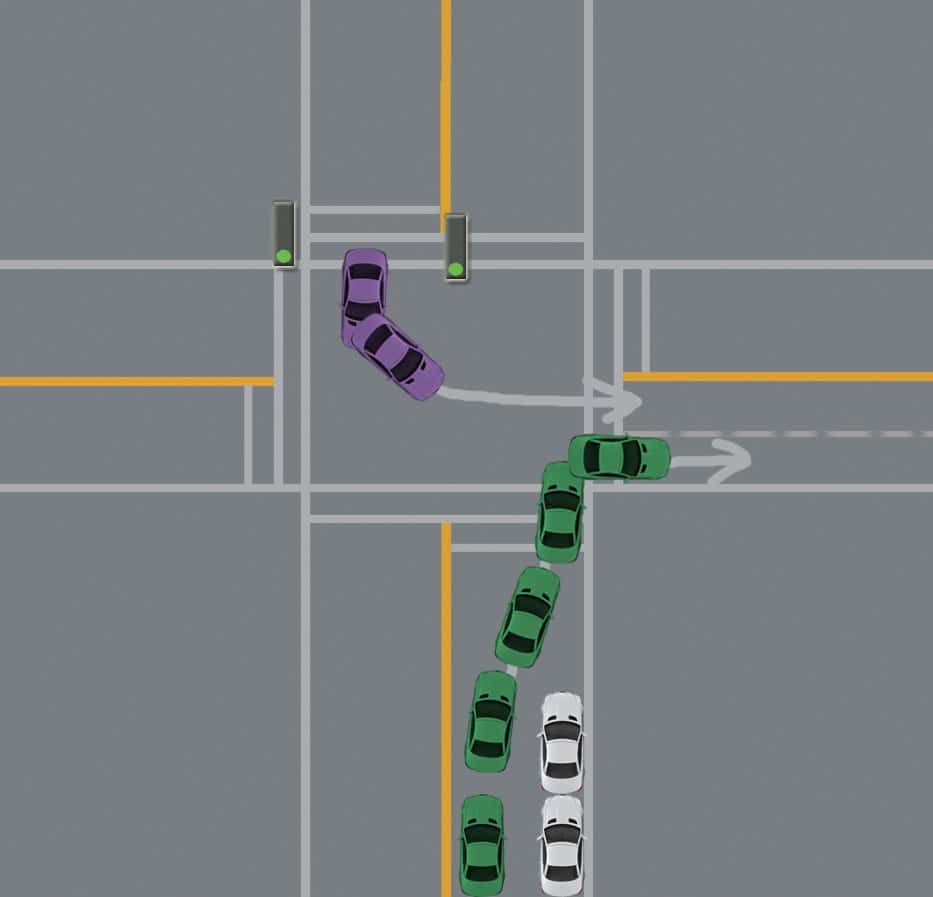
Which Lane Should You Turn Into?
Turn into the ‘proper’ lane when learning how to turn right at a traffic light
Legally when you turn right, you’re required to turn into the right lane; and the driver of any left-turning vehicle is required to turn into the left lane.
How to Turn Right When There’s an HOV Lane
Sometimes there’s an HOV (High Occupancy Vehicle) lane on the road you’re about to turn right onto. In that case, check for warning signs before the intersection. Turn into the lane you will be driving in.
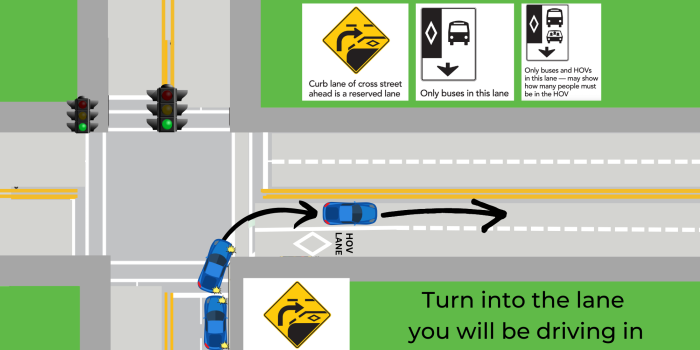
Lane changes after turning right
However, if after you turn there are no vehicles in the other lane, you can quickly change your turn signal to a left signal and make sure it is safe and do a lane change into the left lane fairly quickly.
This is perfectly legal as long as:
- You are not crossing a solid white line and
- It is safe (duh)
- Your left-turn signal is flashing

How to Turn Right at a Green Light – When The Light Turns Yellow
If you’re approaching the intersection for the right turn and the traffic light goes yellow, you are legally required to stop your automobile behind the white line and yield to others, unless it is not safe to stop (point of no return) – just like any other yellow traffic light.
Check out my full article on yellow traffic lights to learn more about that.
Legally speaking, traffic lights control traffic that is approaching intersections; not traffic that has already entered intersections.
Once you are in the middle of the intersection, the traffic light really doesn’t matter and has no legal consequence – you then need to leave when it’s safe and only when it’s safe, that’s it.
How to Turn Right At Green Lights When There’s a Bus
Question: If you are wanting to turn right and notice that there is a bus stop in the very right lane and a bus is currently stopped there, are you allowed to turn into the next lane? This was a two-lane street and the bus was just about a car-length away from the intersection.
Also, what if the very right lane becomes available for meter parking after rush hour? Are you able to turn into the next lane if there is a car parked in the spot closest to the curb? What if there wasn’t a car parked there but further up?
Yes, in the case of buses, you may turn into the next lane. All of the same rules apply. Just keep an eye on the bus in case it turns on its signal, in which case you would need to yield as per usual.
The law says that left turns must yield to right turns when the light is green. It never says that the left lane somehow “belongs” to the left-turning driver. Check out my full left-turning tutorial here.
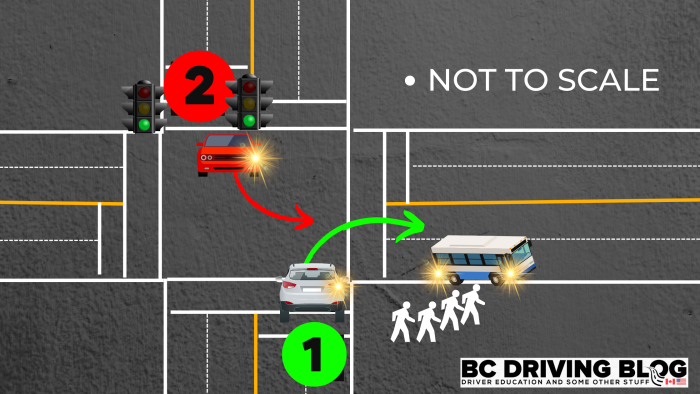
The same applies if there are parked vehicles. You can turn into the first available lane; turn into the lane you are actually going to be driving in. If the parked car is farther up, you should turn into the right lane and then do a lane change.
As a rough guideline, use 1/2 – 3/4 of a block. If it feels like it would be stupid to turn into a small space and then do an impossible lane change, then just turn into the lane you will be driving in. Do what makes sense.
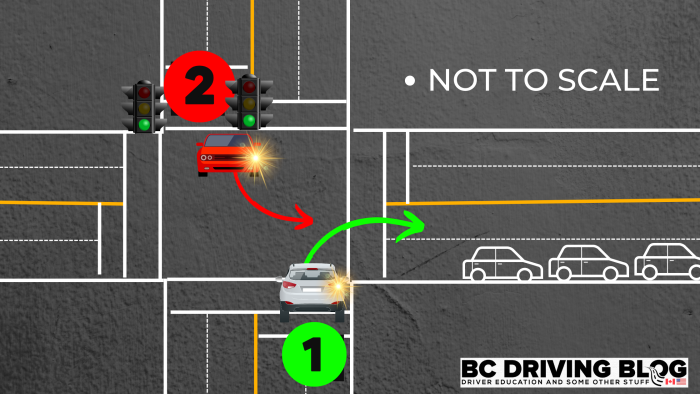
How to Turn Right at a Green Light With a Yield Sign
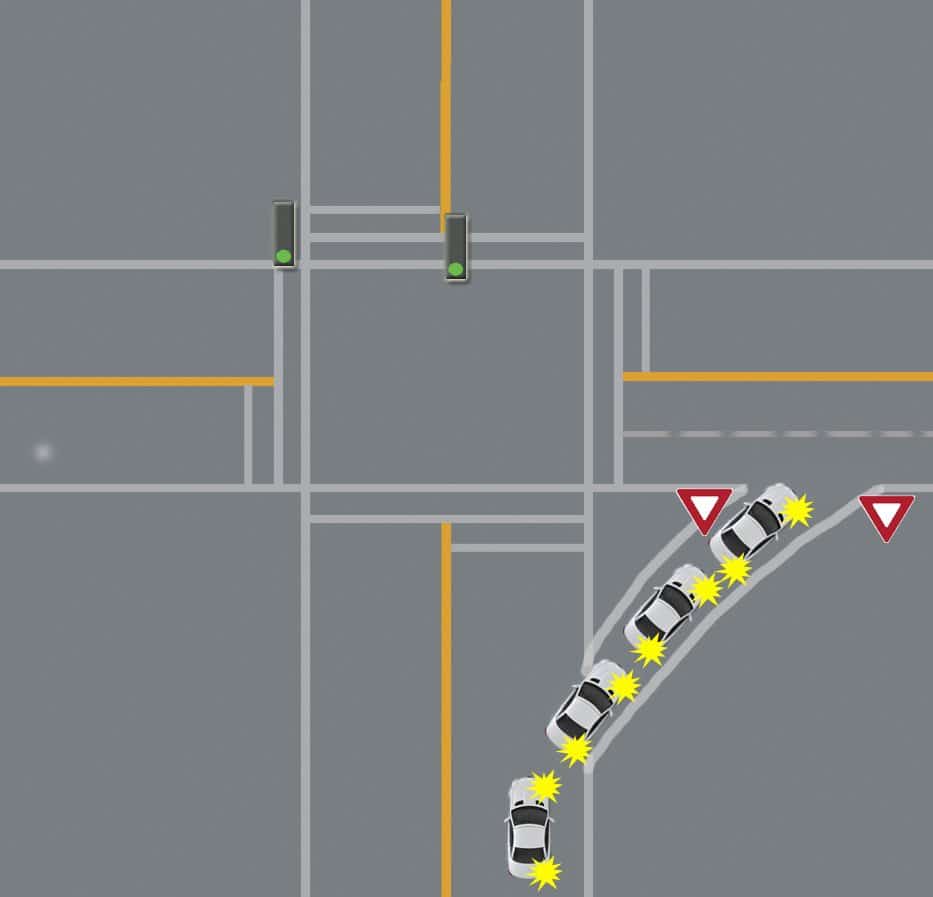
If you’re turning right at a yield sign at an intersection that also has a green light, remember that the traffic control device you need to follow is the yield sign. Check out my full article about yield signs to learn more about them.
Green light offers clues
The green light just happens to be there. It can give you clues.
Use the green light to tell you where the relevant traffic might be coming from, and which particular drivers and/or road users you may need to yield to. Turn on your right signal, as this is still just a right turn.
If The Light Is Green, You May Need To Yield To A Left-Turning Vehicle
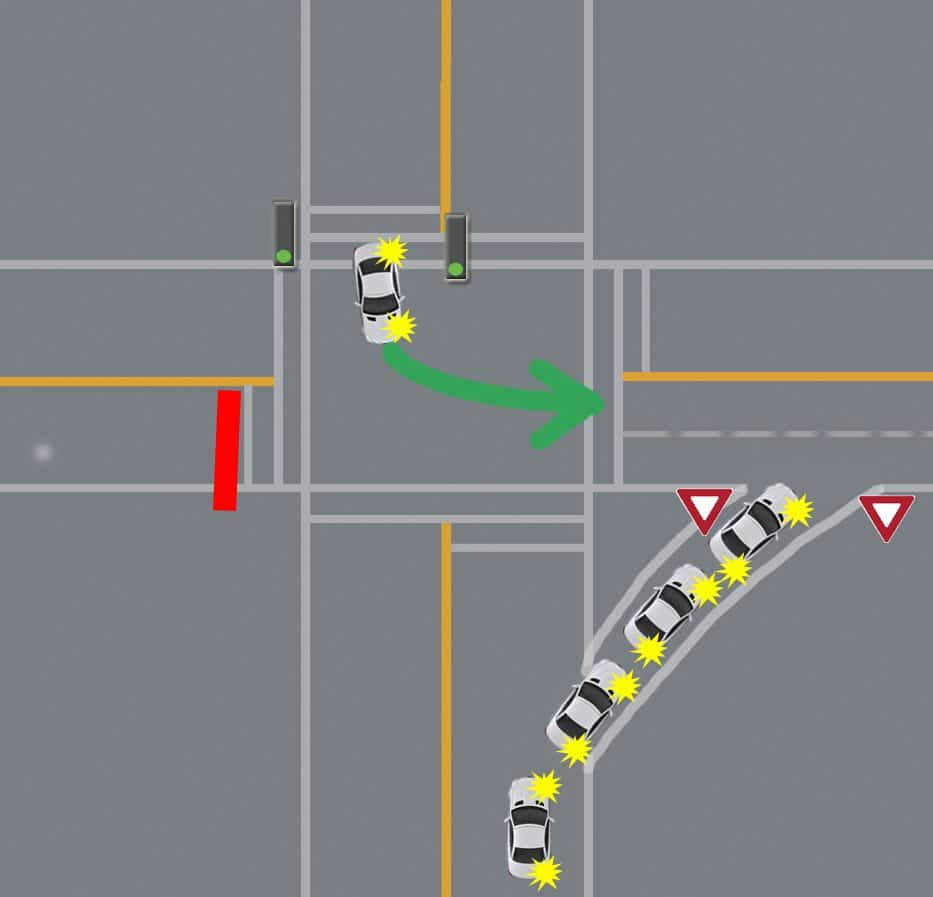
Turning Left After Turning Right At The Yield Sign?
If you’re needing to turn left soon after turning right, then simply yield to both (or all) lanes of traffic. Then, switch your signal to a left signal and continue into the left lane. Remember shoulder checks for lane changes.

Spotted: Baby On Board (Literally)

Omg, I know how to use the word “Literally.” I know, it’s random, isn’t it? It’s funny the things you see when you drive around a lot.
When Can I Go Into a Bus Lane Before a Right Turn?
Pay careful attention to signs and pavement markings. Since it’s illegal to change lanes over a solid white line, make sure the line is dotted before you move. Check out my full article on road lines and pavement markings.
I’m not sure there’s a cut-and-dry answer for this. Do it sometime when it is safe, not crossing solid white lines, and not too far in advance that you are blatantly driving in the bus lane for miles and miles and receive a ticket for that.
Usually, I would aim for about 3/4 – 1/2 of a block. If you wait too long and get too close to the intersection, other vehicles may be in the space, so consider the vehicle behind you and remember to signal early.
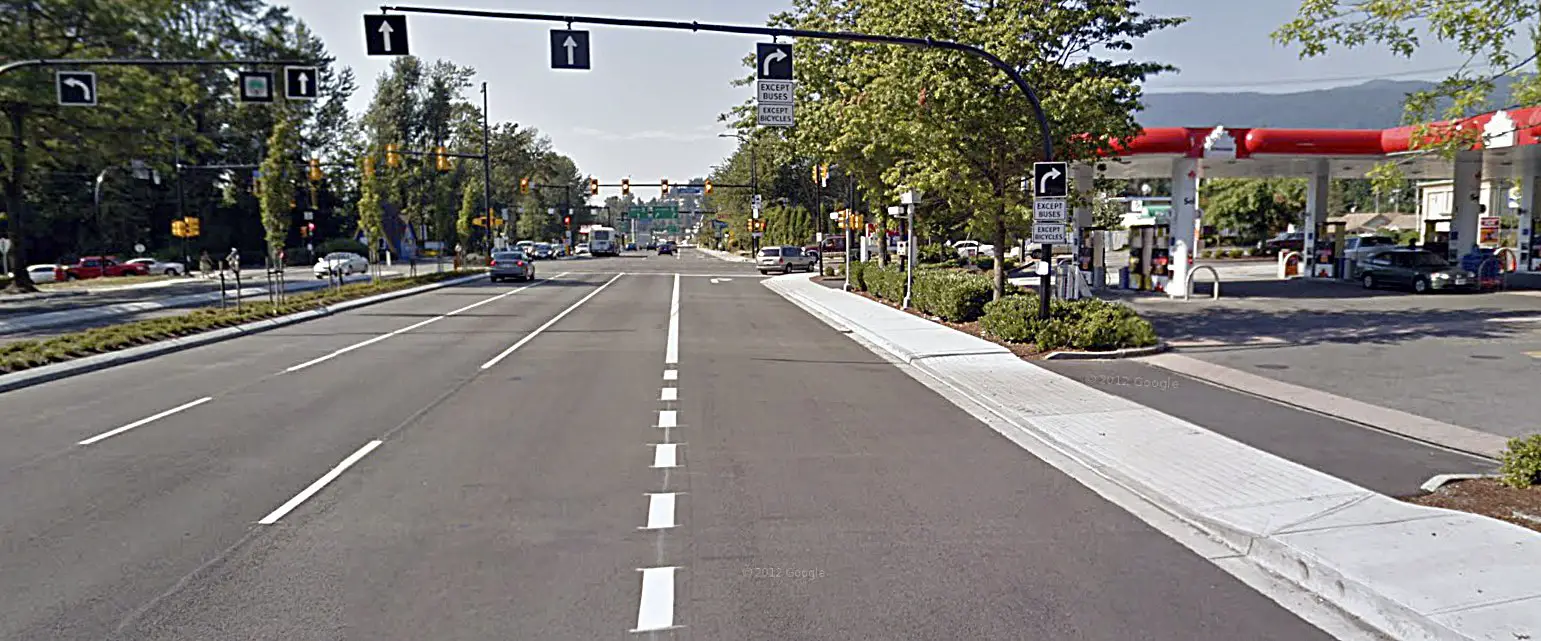
After the last lane-way, might be a good rough guideline:
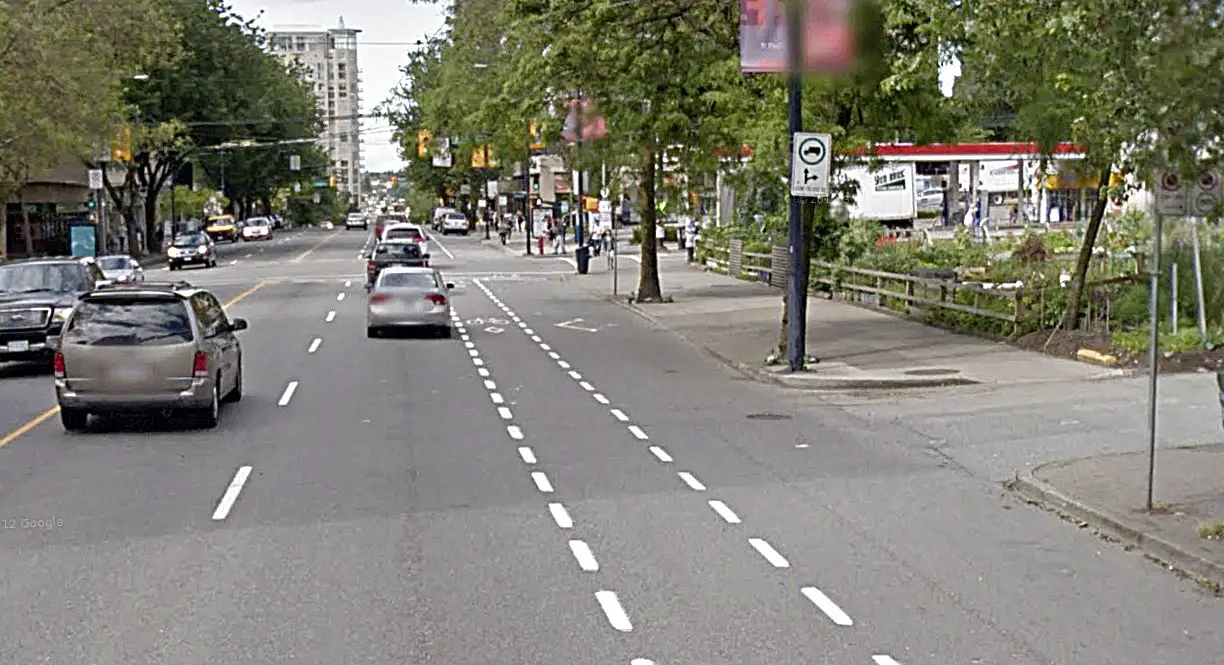
Perhaps, “After the last parked car,” can be a guideline.
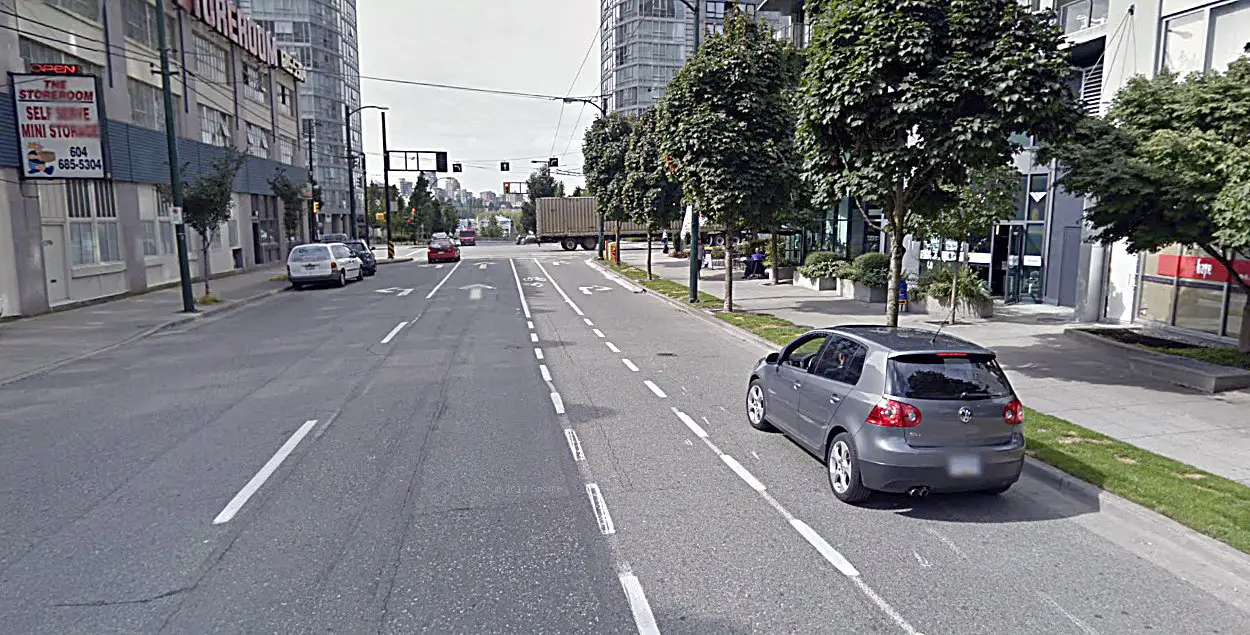
If anyone has a better answer, let me know.
Conclusion – How To Turn Right At Green Lights
Knowing how to turn right at green lights is another necessary skill for all drivers to have. It’s generally a much safer option when compared to turning left at a traffic light.
This is because right turns merely turn across a pedestrian and cyclist path, whereas left turns turn across those, as well as oncoming traffic.
And the thing about the oncoming traffic is:
- It’s dangerous
- It’s unpredictable
- Drivers are often speeding, and this can be hard to judge
- You can’t trust the turn signals; you aren’t sure where the cars are actually going to go
- In the dark, you can’t see the drivers through the windows; during the daytime, you can kind of see if they are paying attention and where they are looking or if they are on their phones or distracted
Sometimes left turns can not be avoided, but sometimes they can by turning right three times and driving in a circle (I mean, “square,” technically speaking).
Practicing your right turns at many different intersections gives you the best possible experience. Always remember to do one and possibly two shoulder checks for these and other right turns, depending on if you’re changing the positioning of your vehicle (to check for cyclists) and/or stopping (time goes by) before your right turn.
This is, of course, to check your blind spot, and mini blind spot mirrors (Amazon affiliate link) can help to reduce surprises.
